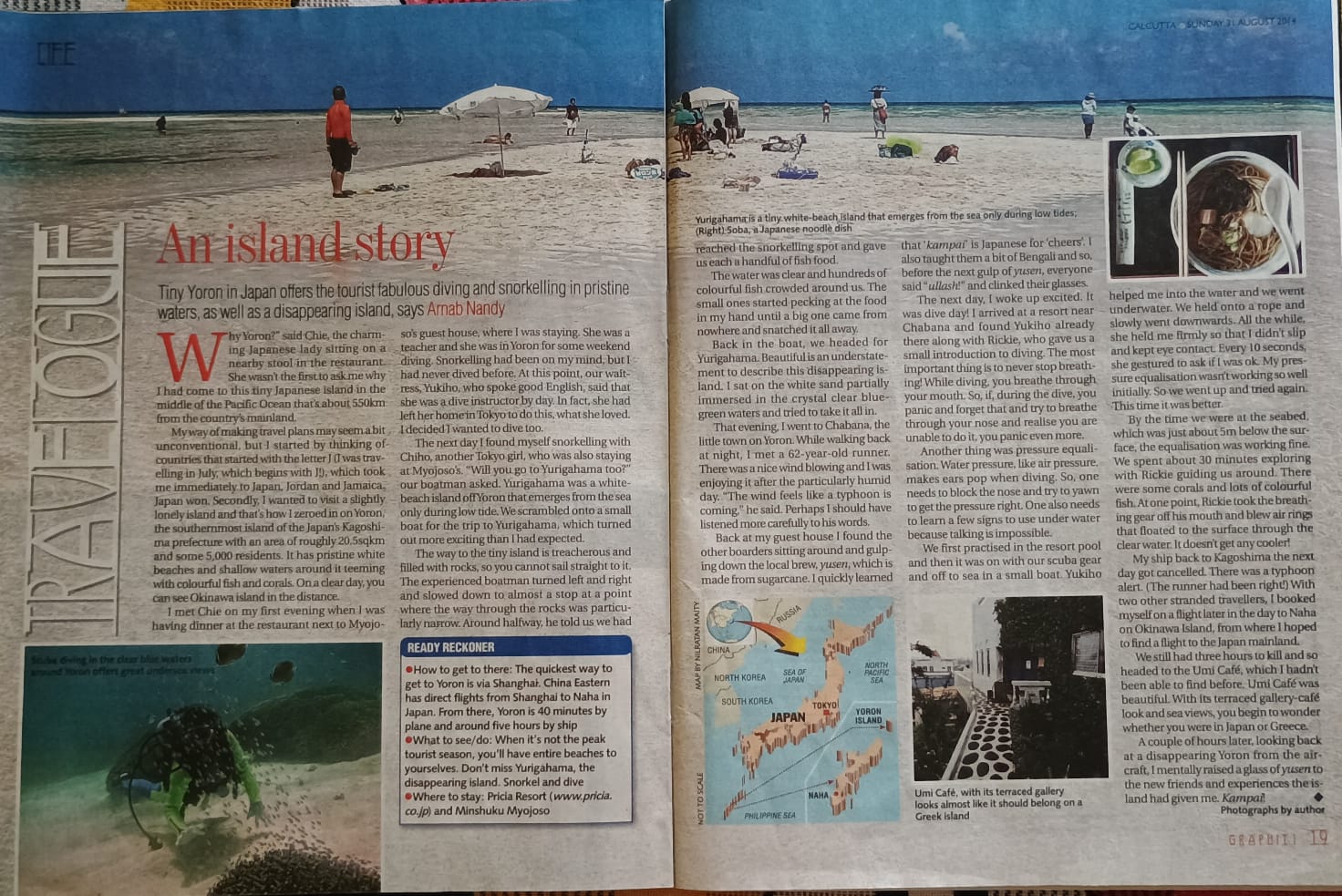“Why Yoron?” said Chie, the charming Japanese lady sitting on a nearby stool in the restaurant. She wasn’t the first to ask me why I had come to this tiny Japanese island in the middle of the Pacific Ocean that’s about 550km from the country’s mainland.
My way of making travel plans may seem a bit unconventional, but I started by thinking of countries that started with the letter J (I was travelling in July, which begins with J!), which took me immediately to Japan, Jordan and Jamaica. Japan won. Secondly, I wanted to visit a slightly lonely island and that’s how I zeroed in on Yoron, the southernmost island of the Japan’s Kagoshima prefecture with an area of roughly 20.5sqkm and some 5,000 residents. It has pristine white beaches and shallow waters around it teeming with colourful fish and corals. On a clear day, you can see Okinawa island in the distance.
I met Chie on my first evening when I was having dinner at the restaurant next to Myojoso’s guest house, where I was staying. She was a teacher and she was in Yoron for some weekend diving. Snorkelling had been on my mind, but I had never dived before. At this point, our waitress, Yukiho, who spoke good English, said that she was a dive instructor by day. In fact, she had left her home in Tokyo to do this, what she loved. I decided I wanted to dive too.
The next day I found myself snorkelling with Chiho, another Tokyo girl, who was also staying at Myojoso’s. “Will you go to Yurigahama too?” our boatman asked. Yurigahama was a white- beach island off Yoron that emerges from the sea only during low tide. We scrambled onto a small boat for the trip to Yurigahama, which turned out more exciting than I had expected.
The way to the tiny island is treacherous and filled with rocks, so you cannot sail straight to it. The experienced boatman turned left and right and slowed down to almost a stop at a point where the way through the rocks was particularly narrow. Around halfway, he told us we had reached the snorkelling spot and gave us each a handful of fish food.
The water was clear and hundreds of colourful fish crowded around us. The small ones started pecking at the food in my hand until a big one came from nowhere and snatched it all away.
Back in the boat, we headed for Yurigahama. Beautiful is an understatement to describe this disappearing island. I sat on the white sand partially immersed in the crystal clear blue- green waters and tried to take it all in.
That evening, I went to Chabana, the little town on Yoron. While walking back at night, I met a 62-year-old runner. There was a nice wind blowing and I was enjoying it after the particularly humid day. “The wind feels like a typhoon is coming,” he said. Perhaps I should have listened more carefully to his words.
Back at my guest house I found the other boarders sitting around and gulping down the local brew, yusen, which is made from sugarcane. I quickly learned that ‘kampai’ is Japanese for ‘cheers. I also taught them a bit of Bengali and so, before the next gulp of yusen, everyone said “ullash!” and clinked their glasses.
The next day, I woke up excited. It was dive day! I arrived at a resort near Chabana and found Yukiho already there along with Rickie, who gave us a small introduction to diving. The most important thing is to never stop breathing! While diving, you breathe through your mouth. So, if, during the dive, you panic and forget that and try to breathe through your nose and realise you are unable to do it, you panic even more.
Another thing was pressure equalisation. Water pressure, like air pressure, makes ears pop when diving. So, one needs to block the nose and try to yawn to get the pressure right. One also needs to learn a few signs to use under water because talking is impossible.
We first practised in the resort pool and then it was on with our scuba gear and off to sea in a small boat. Yukiho helped me into the water and we went underwater. We held onto a rope and slowly went downwards. All the while, she held me firmly so that I didn’t slip and kept eye contact. Every 10 seconds, she gestured to ask if I was ok. My pressure equalisation wasn’t working so well initially. So we went up and tried again. This time it was better.
By the time we were at the seabed, which was just about 5m below the surface, the equalisation was working fine. We spent about 30 minutes exploring with Rickie guiding us around. There were some corals and lots of colourful fish. At one point, Rickie took the breathing gear off his mouth and blew air rings that floated to the surface through the clear water. It doesn’t get any cooler!
My ship back to Kagoshima the next day got cancelled. There was a typhoon alert. (The runner had been right!) With two other stranded travellers, I booked myself on a flight later in the day to Naha on Okinawa Island, from where I hoped to find a flight to the Japan mainland.
We still had three hours to kill and so headed to the Umi Café, which I hadn’t been able to find before. Umi Café was beautiful. With its terraced gallery-café look and sea views, you begin to wonder whether you were in Japan or Greece.
A couple of hours later, looking back at a disappearing Yoron from the aircraft, I mentally raised a glass of yusen to the new friends and experiences the island had given me. Kampai!
